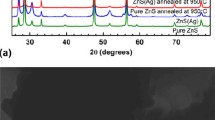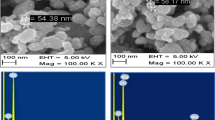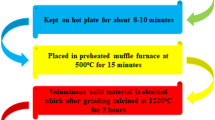Abstract
Herein, we demonstrate a strategy for facile synthesis of pristine MgO nanostructures at different pH values ranging from 7.9, 8.3 and 12.5 to explore their photoluminescence studies. These pH-dependent MgO nanostructures were characterized by various standard techniques such as XRD, SEM, EDS, TEM and photoluminescence (PL) spectroscopy. The obtained PL results clearly demonstrate that the PL emission spectra strongly depend upon growth environment. These nanostructures show a broad PL emission in visible region ranging from 400 to 680 nm at excitation wavelength of 330 nm. Hence, this study provides a unique feature to tailor the PL property of pristine MgO nanostructures which could be potentially used in luminescence harvesting for various optical display devices and sensing applications.






Similar content being viewed by others
References
Roessler DM, Walker WC (1967) Electronic spectrum and ultraviolet optical properties of crystalline MgO. Phys Rev 159:733–738
Jain N, Marwaha N, Verma R, Gupta BK, Srivastava AK (2016) Facile synthesis of defect-induced highly luminescent pristine MgO nanostructures for promising solid-state lighting applications. RSC Adv 6:4960–4968
Suresh S (2014) Investigations on synthesis, structural and electrical properties of MgO nanoparticles by sol–gel method. J Ovonic Res 10:205–210
Florez E, Fuentealba P, Mondragon F (2008) Chemical reactivity of oxygen vacancies on the MgO surface: reactions with CO2, NO2 and metals. Catal Today 133:216–222
Vu AT, Jiang S, Kim YH, Lee CH (2014) Controlling the physical properties of magnesium oxide using a calcination method in aerogel synthesis: its application to enhanced sorption of a sulfur compound. Ind Eng Chem Res 53:13228–13235
Uchino T, Okutsu D, Katayama R, Sawai S (2009) Mechanism of stimulated optical emission from MgO microcrystals with color centers. Phys Rev B Condens Mater Phys 79:165107-1–165107-8
Shao C, Guan H, Liu Y (2006) MgO nanofibres via an electrospinning technique. J Mater Sci 41:3821–3824. doi:10.1007/s10853-005-5623-3
Taleshi F, Hosseini AA (2012) Synthesis of uniform MgO/CNT nanorods by precipitation method. J Nanostruct Chem 3:4
Mageshwari K, Sathyamoorthy R (2012) Studies on photocatalytic performance of MgO nanoparticles prepared by wet chemical method. Trans Indian Inst Met 65:49–55
Vinogradov AV, Vinogradov VV (2014) Low-temperature sol–gel synthesis of crystalline materials. RSC Adv 4:45903–45919
Cui H, Wu X, Chen Y, Boughton RI (2014) Synthesis and characterization of mesoporous MgO by template-free hydrothermal method. Mater Res Bull 50:307–311
Verma R, Naik KK, Gangwar J, Srivastava AK (2014) Morphology, mechanism and optical properties of nanometer-sized MgO synthesized via facile wet chemical method. Mater Chem Phys 148:1064–1070
Sternig A, Stankic S, M¨uller M, Bernardi J, Knozinger E, Diwald O (2008) Photoluminescent nanoparticle surfaces: the potential of alkaline earth oxides for optical applications. Adv Mater 20:4840–4844
Gangwar J, Gupta BK, Tripathi SK, Srivastava AK (2015) Phase dependent thermal and spectroscopic responses of different morphogenesis of Al2O3 nanostructures. Nanoscale 7:13313–13344
Stankic S, Bernardi J, Diwald O, Zinger EK (2006) How anesthetics, neurotransmitters, and antibiotics influence the relaxation processes in lipid membranes. J Phys Chem B 110:13858–13866
Remon A, Gagacia JA, Piquras J (1986) Red luminescence from deformed MgO crystals. J Phys Chem Solids 47:577–580
Pikhitsa PV, Kim C, Chae S, Shin S, Jung S, Kitaura M, Kimura S, Fukui K, Choi M (2015) Two-band luminescence from an intrinsic defect in spherical and terraced MgO nanoparticles. Appl Phys Lett 106:183106
Vingurt D, Fuks D, Landau MV, Vidrukb R, Herskowitz M (2013) Grain boundaries at the surface of consolidated MgO nanocrystals and acid–base, functionality. Phys Chem Chem Phys 15:14783–14796
Ertekin E, Wagner LK, Grossman JC (2013) Point-defect optical transitions and thermal ionization energies from quantum Monte Carlo methods: application to the F-center defect in MgO. Phys Rev B 87:155210-1–155210-7
Gerson AR, Bredow T (1999) MgO (100) Surface relaxation and vacancy defects: a semi-empirical quantum-chemical study. Phys Chem Chem Phys 1:4889–4896
Yang H, Yang SH, Takahashi S, Maekawa S, Parkin SSP (2010) Extremely long quasiparticle spin lifetimes in superconducting aluminium using MgO tunnel spin injectors. Nat Mater 9:586–593
Acknowledgements
We thank the Director, NPL New Delhi, India, for providing the necessary experimental facilities. Dr. Sushil Kumar, Dr. H. K Singh, Dr. Govind, Sh. Dinesh Singh and Sh. K. N. Sood are gratefully acknowledged for providing the necessary help and instrumentation facility for electron microscopy. The Project NanoSHE (BSC-0112) is gratefully acknowledged.
Author information
Authors and Affiliations
Corresponding author
Rights and permissions
About this article
Cite this article
Marwaha, N., Gupta, B.K., Verma, R. et al. Facile synthesis and characterization of pH-dependent pristine MgO nanostructures for visible light emission. J Mater Sci 52, 10480–10484 (2017). https://doi.org/10.1007/s10853-017-1231-2
Received:
Accepted:
Published:
Issue Date:
DOI: https://doi.org/10.1007/s10853-017-1231-2




